GINÉS DE PASAMONTE Y PEDRO DE URDEMALAS EN LA ESCRITURA ESPERPÉNTICA DE RAMÓN DEL VALLE-INCLÁN
Resumen
Valle-Inclán dialoga constantemente con Cervantes en términos de hipertextualidad. Específicamente, en las farsas La marquesa Rosalinda y Farsa italiana de la enamorada del rey reúne el paradigma de Ginés de Pasamonte / Pedro de Urdemalas para mostrarnos la disolución del Modernismo en términos meta-teatrales. Por último, en la época del esperpento, Divinas palabras y Los cuernos de Don Friolera celebran la derrota de cualquier posibilidad de transformar la sórdida realidad por los medios del teatro (Urdemalas), y el triunfo del paradigma picaresco del titiritero y el demiurgo Ginés de Pasamonte/Maese Pedro, uno de los principales modelos de los titiriteros de Valle.
Descargas
Descargas
Publicado
2019-06-04
Cómo citar
Trambaioli, M. (2019). GINÉS DE PASAMONTE Y PEDRO DE URDEMALAS EN LA ESCRITURA ESPERPÉNTICA DE RAMÓN DEL VALLE-INCLÁN. Hesperia: Anuario De Filología Hispánica, 10, 223–243. Recuperado a partir de https://revistas.uvigo.es/index.php/AFH/article/view/528
Número
Sección
Artículos











